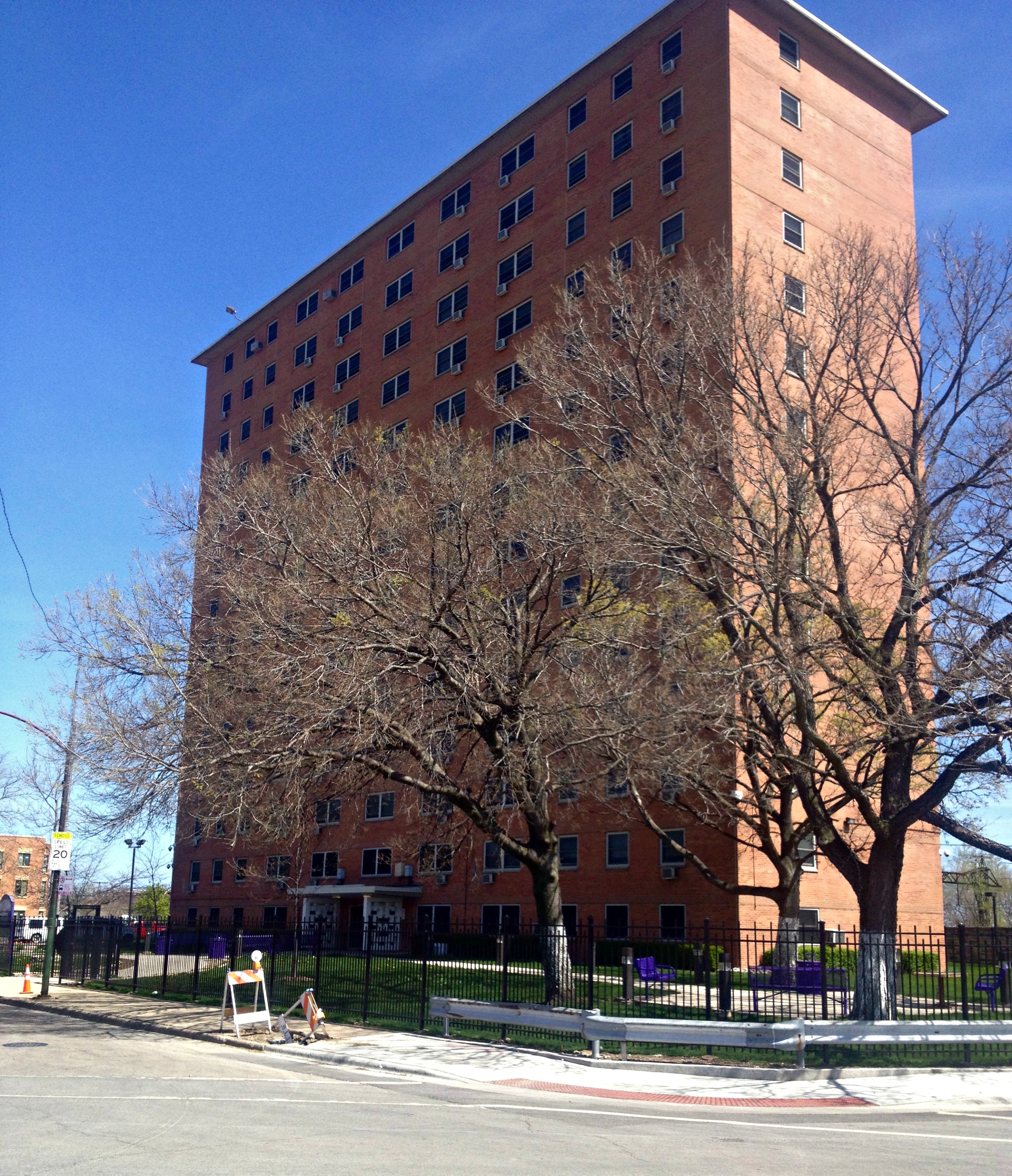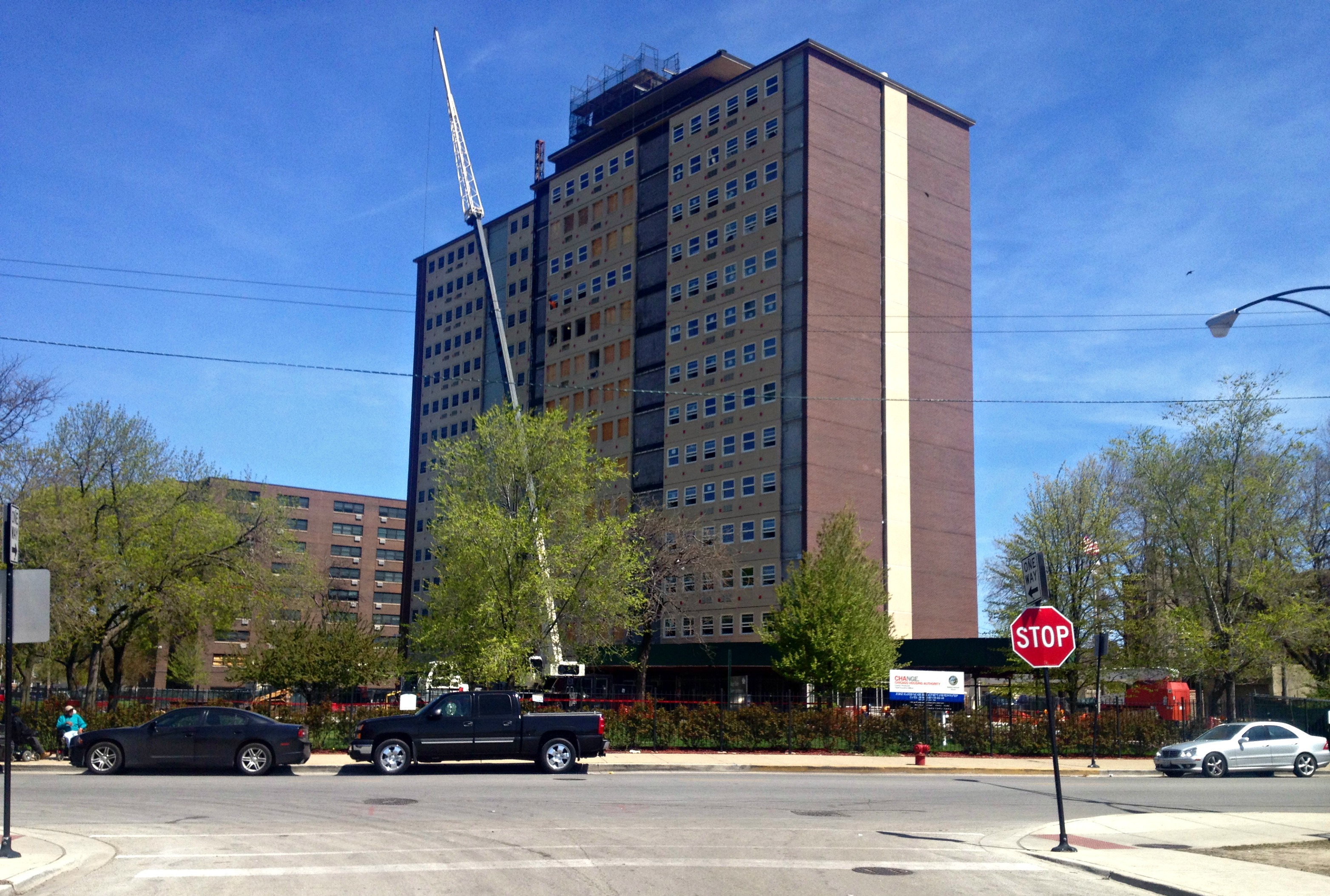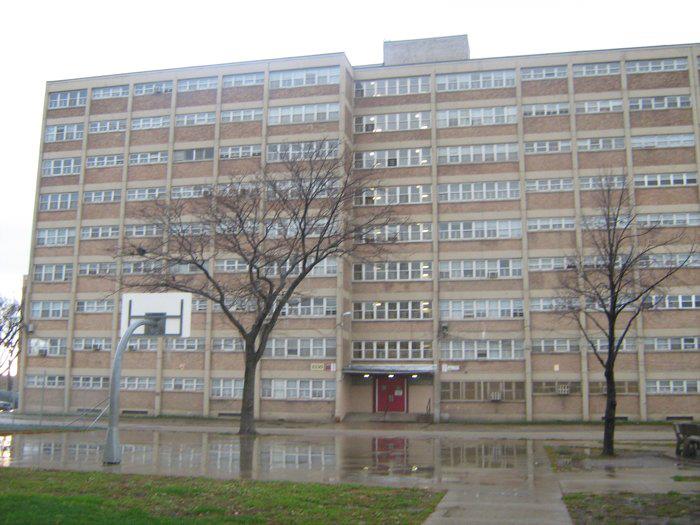Chicago Housing Authority on:
[Wikipedia]
[Google]
[Amazon]
The Chicago Housing Authority (CHA) is a
Plan For Transformation
which called for the demolition of all of its gallery high-rise buildings and proposed a renovated housing portfolio totaling 25,000 units. In April 2013, CHA create
Plan Forward
the next phase of redeveloping public housing in Chicago. The plan includes the rehabilitation of other scattered-site, senior, and lower-density properties; construction of mixed-income housing; increasing economic sales around CHA developments; and providing educational and job training to residents with Section 8 vouchers. The Plan for Transformation has also been plagued with problems. While demolition began almost immediately, CHA was slow to develop mixed-income units or provide Section 8 vouchers as planned. In 2015, the Secretary of Housing and Urban Development criticized the Chicago Housing Authority for accumulating a cash reserve of $440 million at a time when more than a quarter million people were on the agency's waiting list for affordable housing, and a large number of units (16%) remained vacant. In March 2017, only 8% of the 17,000 demolished households had been replaced with mixed-income units. Many lots remain vacant decades after demolition, and the CHA has been selling, leasing, or trading land in gentrifying neighborhoods to other government agencies and the private sector for less than market value. Land owned by the CHA has been used to build two Target stores, a private tennis complex, and government facilities at a time when over 30,000 people are awaiting housing assistance from the CHA. One Chicago resident, Jeanette Taylor, applied for housing assistance as a single mother in 1993 and received an approval letter almost thirty years later in 2022. More than 20 years after the initial plan was announced, Chicago









Mixed-Income Properties: Chicago Housing Authority
"Chicago hope: Ambitious attempt to help the city’s poor by moving them out of troubled housing projects is having mixed results, MIT study finds"
''MIT News'', MIT News Office, March 3, 2011. * Blueprint for Disaster: The Unraveling of Chicago Public Housing, a 2009 book by D. Bradford Hunt. * "Understanding Chicago's High-Rise Public Housing Disaster", in Chicago Architecture: Histories, Revisions, and Alternatives, edited by Charles Waldheim and Katerina Reudi Ray (University of Chicago Press, 2005). * "How Did Public Housing Survive the 1950s?", Journal of Policy History, 17:2, Spring 2005, 193–216.
municipal corporation
A municipal corporation is the legal term for a local governing body, including (but not necessarily limited to) cities, counties, towns, townships, charter townships, villages, and boroughs. The term can also be used to describe municipally ...
that oversees public housing within the city of Chicago. The agency's Board of Commissioners is appointed by the city's mayor, and has a budget independent from that of the city of Chicago. CHA is the largest rental landlord in Chicago, with more than 50,000 households. CHA owns over 21,000 apartments (9,200 units reserved for seniors and over 11,400 units in family and other housing types). It also oversees the administration of 37,000 Section 8 vouchers. The current acting CEO of the Chicago Housing Authority is Tracey Scott.
History
The CHA was created in 1937 to own and operate housing built by the federal government's Public Works Administration. In addition to providing affordable housing for low-income families and combating blight, it also provided housing for industry workers during World War II and returning veterans after the war. By 1960, it was the largest landlord in Chicago. In 1965, a group of residents sued the CHA for racial discrimination. After the landmark court decision ''Gautreaux v. Chicago Housing Authority'' (see below), the CHA was placed inreceivership
In law, receivership is a situation in which an institution or enterprise is held by a receiver—a person "placed in the custodial responsibility for the property of others, including tangible and intangible assets and rights"—especially in c ...
, which would last for more than 20 years. Things continued to deteriorate for the agency and its residents, and by the 1980s, the high concentrations of poverty and neglected infrastructure were severe. The Chicago Housing Authority Police Department was created in 1989 to provide dedicated policing for what had become one of the most impoverished and crime-ridden housing developments in the country, and was dissolved only ten years later. The situation was so dire that the entire CHA board of commissioners resigned in 1995, effectively handing over control of the agency to Housing and Urban Development
The United States Department of Housing and Urban Development (HUD) is one of the executive departments of the U.S. federal government. It administers federal housing and urban development laws. It is headed by the Secretary of Housing and Ur ...
. After an extensive overhaul, management of the CHA was returned to a new board of commissioners, including three residents appointed by resident groups, in 1999. The previously ordered receivership ended in 2010.
Plan for Transformation/Plan Forward
In 2000, the CHA began itPlan For Transformation
which called for the demolition of all of its gallery high-rise buildings and proposed a renovated housing portfolio totaling 25,000 units. In April 2013, CHA create
Plan Forward
the next phase of redeveloping public housing in Chicago. The plan includes the rehabilitation of other scattered-site, senior, and lower-density properties; construction of mixed-income housing; increasing economic sales around CHA developments; and providing educational and job training to residents with Section 8 vouchers. The Plan for Transformation has also been plagued with problems. While demolition began almost immediately, CHA was slow to develop mixed-income units or provide Section 8 vouchers as planned. In 2015, the Secretary of Housing and Urban Development criticized the Chicago Housing Authority for accumulating a cash reserve of $440 million at a time when more than a quarter million people were on the agency's waiting list for affordable housing, and a large number of units (16%) remained vacant. In March 2017, only 8% of the 17,000 demolished households had been replaced with mixed-income units. Many lots remain vacant decades after demolition, and the CHA has been selling, leasing, or trading land in gentrifying neighborhoods to other government agencies and the private sector for less than market value. Land owned by the CHA has been used to build two Target stores, a private tennis complex, and government facilities at a time when over 30,000 people are awaiting housing assistance from the CHA. One Chicago resident, Jeanette Taylor, applied for housing assistance as a single mother in 1993 and received an approval letter almost thirty years later in 2022. More than 20 years after the initial plan was announced, Chicago
Mayor
In many countries, a mayor is the highest-ranking official in a municipal government such as that of a city or a town. Worldwide, there is a wide variance in local laws and customs regarding the powers and responsibilities of a mayor as well ...
Lori Lightfoot
Lori Elaine Lightfoot (born August 4, 1962) is an American attorney and politician serving since 2019 as the 56th mayor of Chicago. She is a member of the Democratic Party. Before becoming mayor, Lightfoot worked in private legal practice as ...
announced in June 2021 that finishing the redevelopment of Cabrini-Green alone will take at least another 12 years and could total upwards of $1 billion.
Demographics
From its beginning until the late-1950s, most families that lived in Chicago housing projects wereItalian
Italian(s) may refer to:
* Anything of, from, or related to the people of Italy over the centuries
** Italians, an ethnic group or simply a citizen of the Italian Republic or Italian Kingdom
** Italian language, a Romance language
*** Regional Ita ...
immigrants. By the mid-1970s, 65% of the agency's housing projects were made up of African Americans. In 1975, a study showed that traditional mother and father families in CHA housing projects were almost non-existent and 93% of the households were headed by single females. In 2010, the head of households demographics were 88% African American and 12% White. The population of children in CHA decreased from 50% in 2000 to 35% by 2010. Today on average, a Chicago public housing development is made up of: 69% African-American
African Americans (also referred to as Black Americans and Afro-Americans) are an ethnic group consisting of Americans with partial or total ancestry from sub-Saharan Africa. The term "African American" generally denotes descendants of ensl ...
, 27% Latino, and 4% White
White is the lightest color and is achromatic (having no hue). It is the color of objects such as snow, chalk, and milk, and is the opposite of black. White objects fully reflect and scatter all the visible wavelengths of light. White o ...
and Other.
List of Chief Executive Officers
Lawsuits
''Gautreaux v. Chicago Housing Authority''
In 1966, Dorothy Gautreaux and other CHA residents brought a suit against the CHA in ''Gautreaux v. Chicago Housing Authority.'' The suit chargedracial discrimination
Racial discrimination is any discrimination against any individual on the basis of their skin color, race or ethnic origin.Individuals can discriminate by refusing to do business with, socialize with, or share resources with people of a certain g ...
by the housing authority for concentrating 10,000 public housing units in isolated Black
Black is a color which results from the absence or complete absorption of visible light. It is an achromatic color, without hue, like white and grey. It is often used symbolically or figuratively to represent darkness. Black and white ...
neighborhoods. It claimed that the CHA and Housing and Urban Development (HUD) had violated the U.S. Constitution and the 1964 Civil Rights Act. It was a long-running case that in 1987 resulted in HUD taking over the CHA for over 20 years and the formation of the Gautreaux Project
The Gautreaux Project is a US housing-desegregation project initiated by court order. It is notable both for being one of the only social programs based in a randomized experiment, and the only anti-poverty housing program endorsed by the Reagan, ...
in which public housing families were relocated to the suburbs. The lawsuit was noted as the nation's first major public housing desegregation
Desegregation is the process of ending the separation of two groups, usually referring to races. Desegregation is typically measured by the index of dissimilarity, allowing researchers to determine whether desegregation efforts are having impact o ...
lawsuit.
Other lawsuits
In May 2013, The Cabrini–Green Local Advisory Council and former residents of theCabrini–Green Homes
Cabrini–Green Homes was a Chicago Housing Authority (CHA) public housing project on the Near North Side of Chicago, Illinois. The Frances Cabrini Rowhouses and Extensions were south of Division Street, bordered by Larrabee Street to the west, ...
sued the housing authority for reneging on promises for the residents to return the neighborhood after redevelopment. The suit claimed that the housing authority at the time had only renovated a quarter of the remaining row-houses, making only a small percentage of them public housing.
In September 2015, four residents sued the housing authority over utility allowances. Residents claimed the CHA overcharged them for rent and didn't credit them for utility costs.








Developments
Housing projects
Other housing
In addition to the traditional housing projects, CHA has 51 senior housing developments, 61 scattered site housing and 15 mixed-income housing developments.Notable residents
* R. Kelly – Ida B. Wells Homes *Mr. T
Mr. T (born Laurence Tureaud, May 21, 1952), is an American actor. He is known for his roles as B. A. Baracus in the 1980s television series ''The A-Team'' and as boxer Clubber Lang in the 1982 film ''Rocky III''. He is also known for his ...
– Robert Taylor Homes
* Maurice Cheeks
Maurice Edward Cheeks (born September 8, 1956) is an American professional basketball coach and former player who serves as assistant coach for the Chicago Bulls of the National Basketball Association (NBA). He has also served as head coach of t ...
– Robert Taylor Homes
* Curtis Mayfield
Curtis Lee Mayfield (June 3, 1942 – December 26, 1999) was an American singer-songwriter, guitarist, and record producer, and one of the most influential musicians behind soul and politically conscious African-American music.
– Cabrini–Green Homes
* Eric Monte
Eric Monte (born Kenneth Williams; December 25, 1943) is an American screenwriter and TV series creator. He is known for his work in
depicting 1970s African-American culture. Monte wrote and co-created several sitcoms for television such as ''Goo ...
– Cabrini–Green Homes
* Jerry Butler
Jerry Butler Jr. (born December 8, 1939) is an American soul singer-songwriter, producer, musician, and retired politician. He was the original lead singer of the R&B vocal group the Impressions, inducted into the Rock and Roll Hall of Fame i ...
– Cabrini–Green Homes
* Kirby Puckett
Kirby Puckett (March 14, 1960 – March 6, 2006) was an American professional baseball player. He played his entire 12-year Major League Baseball (MLB) career as a center fielder for the Minnesota Twins (1984–1995). Puckett is the Twins' all-ti ...
– Robert Taylor Homes
* Deval Patrick – Robert Taylor Homes
* Marvin Smith
Marvin "Smitty" Smith (born June 24, 1961) is an American jazz drummer and composer.
Marvin Smith was born in Waukegan, Illinois, where his father, Marvin Sr., was a drummer. "Smitty" was exposed to music at a young age, receiving formal musica ...
– Robert Taylor Homes
* Lou Rawls – Ida B. Wells Homes
See also
* '' Hills v. Gautreaux'', a 1976 Supreme Court case * Chicago Housing Authority Police Department * Marshall Field Garden ApartmentsReferences
* * *Further reading
* Dizikes, Peter"Chicago hope: Ambitious attempt to help the city’s poor by moving them out of troubled housing projects is having mixed results, MIT study finds"
''MIT News'', MIT News Office, March 3, 2011. * Blueprint for Disaster: The Unraveling of Chicago Public Housing, a 2009 book by D. Bradford Hunt. * "Understanding Chicago's High-Rise Public Housing Disaster", in Chicago Architecture: Histories, Revisions, and Alternatives, edited by Charles Waldheim and Katerina Reudi Ray (University of Chicago Press, 2005). * "How Did Public Housing Survive the 1950s?", Journal of Policy History, 17:2, Spring 2005, 193–216.
External links
* {{Authority control Government of Chicago 1937 establishments in Illinois